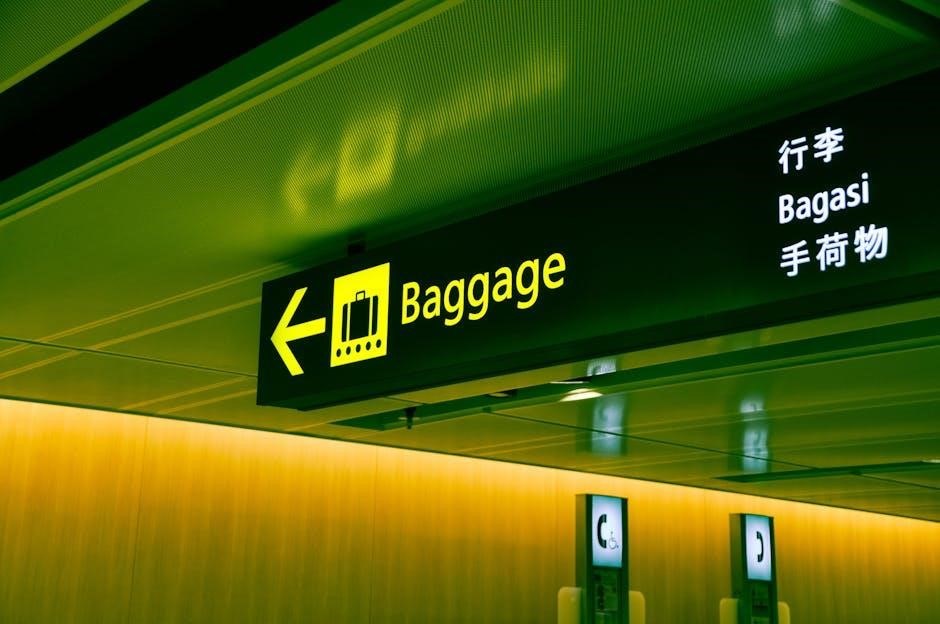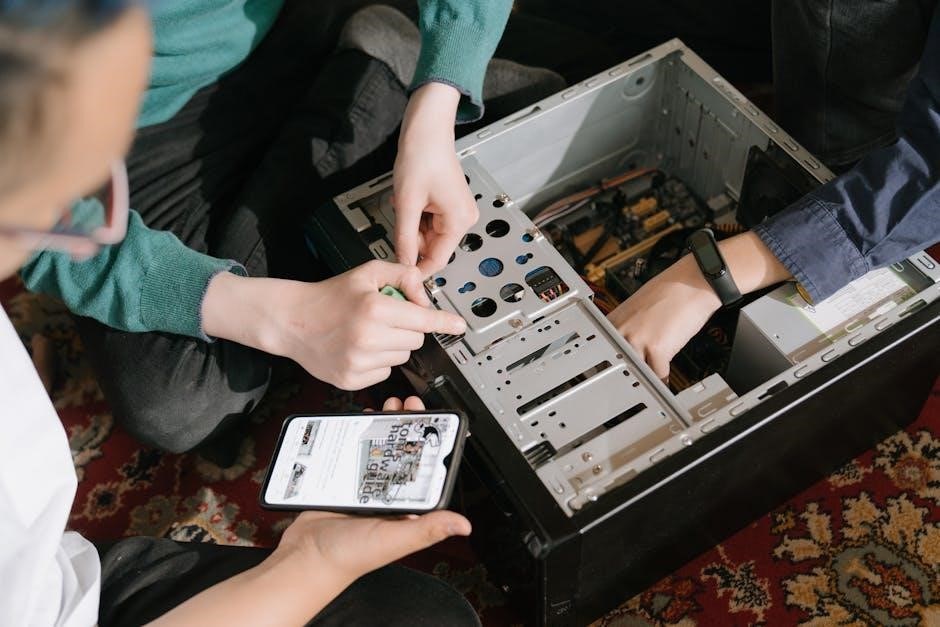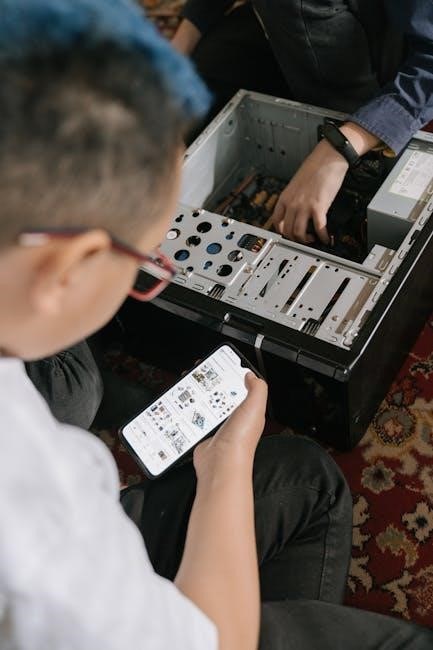gas heater troubleshooting guide

Gas heater troubleshooting involves identifying issues like pilot light problems or insufficient heat, ensuring safety, and knowing when to DIY or call a professional for efficiency.
1.1 Understanding Common Issues in Gas Heaters
Common gas heater issues include pilot light problems, insufficient heat output, and system overpressurization. Troubleshooting often involves checking the pilot orifice for blockages, ensuring proper gas flow, and inspecting thermostat settings. Addressing these issues promptly is crucial to maintain safety, efficiency, and reliability. Regular maintenance can prevent many of these problems, but understanding the root causes is essential for effective DIY or professional interventions.
1.2 Importance of Regular Maintenance
Regular maintenance is crucial for ensuring gas heaters operate safely and efficiently. It helps prevent carbon monoxide leaks, a major health risk, and avoids costly repairs. Annual servicing by professionals can identify and fix issues before they escalate, improving performance and extending the heater’s lifespan. Proper upkeep also ensures compliance with safety standards, protecting both residents and property.

Common Pilot Light Issues
Pilot light issues, such as not staying lit, being too small, or not lighting at all, are frequent problems that can affect combustion efficiency and safety.
2.1 Pilot Light Not Staying Lit
A pilot light that won’t stay lit can stem from a clogged pilot orifice, restricting gas flow, or issues with the thermopile. A small or uneven flame may fail to generate enough voltage to keep the gas valve open, causing the heater to malfunction. Regular cleaning and ensuring proper gas supply are essential to resolve this common issue effectively.
2.2 Pilot Light Too Small or Uneven
A pilot light that’s too small or uneven may indicate a clogged pilot orifice, dirt buildup, or incorrect gas pressure settings. This can lead to insufficient heat generation and heater inefficiency. Cleaning the orifice and adjusting the gas flow often resolve the issue, ensuring a stable and adequate flame for proper heater operation and safety.
2.3 Pilot Light Not Lighting at All
If the pilot light fails to ignite, it could be due to a faulty igniter, blocked gas supply, or issues with the thermocouple. Checking the gas valve, ensuring propane supply, and cleaning the pilot orifice are essential steps. If problems persist, consulting an HVAC specialist is recommended to avoid safety hazards and ensure proper heater function.

Troubleshooting Heating Performance Problems
Identify issues like insufficient heat or frequent cycling. Check thermopile function, gas supply, and thermostat settings. Consult a professional if problems persist for optimal efficiency and safety.
3.1 Heater Not Producing Enough Heat
If your gas heater isn’t producing enough heat, check for issues like a clogged pilot orifice, malfunctioning thermopile, or incorrect thermostat settings. Ensure proper gas flow and inspect ducts for leaks or blockages. In some cases, the heater may be undersized for the space. Always prioritize safety and consider consulting a professional if the problem persists after basic troubleshooting steps.
3.2 Heater Cycling On and Off Frequently
Frequent cycling of your gas heater could indicate a malfunctioning thermostat, improper installation, or issues with the gas supply. Check if the thermostat is calibrated correctly and ensure the heater is sized appropriately for the space. Faulty components like the flame sensor or gas valve may also cause this issue. If the problem persists, consult a professional to diagnose and repair the system for optimal performance and safety.

Error Codes and Their Meanings
Gas heaters display error codes to indicate specific issues, such as faulty sensors, ignition problems, or system malfunctions. These codes help diagnose and resolve problems efficiently.
4.1 Common Error Codes in Gas Heaters
Gas heaters often display specific error codes like E01, E02, or E03, indicating issues such as faulty ignition, sensor malfunctions, or blocked vents. Understanding these codes helps users identify the root cause and take appropriate action, whether resetting the system or calling a technician. Referencing the user manual is essential for accurate diagnosis and resolution.
4.2 How to Interpret and Resolve Error Codes
To address error codes, consult the heater’s manual for specific code meanings. Common codes like E01 (ignition failure) or E02 (sensor issues) often require resetting or cleaning. For E03 (low gas pressure), check fuel supply lines. If unresolved, turn off the heater and contact a certified technician. Always prioritize safety and avoid guessing, as incorrect fixes can worsen issues or pose risks.

Safety Precautions and Health Concerns
Ensure proper ventilation to avoid carbon monoxide risks. Faulty heaters can cause health issues like headaches or dizziness. Install CO alarms for early detection and schedule regular servicing to prevent breakdowns and ensure safe operation.
5.1 Health Risks of Faulty Gas Heaters
Faulty gas heaters can release carbon monoxide, leading to severe health risks, including headaches, dizziness, and even death. Prolonged exposure may cause respiratory issues and long-term health damage. Proper ventilation and regular servicing are essential to prevent these dangers and ensure safe operation of gas heating systems.
5.2 Importance of Carbon Monoxide Alarms
Carbon monoxide alarms are crucial for detecting deadly gas leaks from faulty heaters. These devices alert homeowners to dangerous levels of CO, preventing poisoning and ensuring safety. Installing and maintaining CO alarms is essential for protecting health and providing peace of mind when using gas heating systems.

Tools and Equipment for Troubleshooting
Essential tools include multimeters, pressure gauges, and thermometers for diagnosing issues. Advanced equipment like gas detectors ensures safety and accurate troubleshooting of gas heater problems.
6.1 Basic Tools for DIY Troubleshooting
For DIY gas heater troubleshooting, essential tools include a multimeter for voltage checks, screwdrivers for accessing components, and a manometer to measure gas pressure. Additionally, a wrench for gas line connections and a carbon monoxide detector ensure safety. These tools help identify common issues like faulty pilots or blocked vents without requiring advanced equipment.
6.2 Advanced Diagnostic Equipment
Advanced tools for gas heater troubleshooting include digital gas analyzers to measure combustion efficiency, infrared cameras to detect heat leaks, and combustion analyzers for precise air-fuel mixture readings. These tools help identify complex issues like gas leaks, ignition problems, or internal component malfunctions. Professionals often use these devices to ensure accurate diagnostics and optimize heater performance, enhancing safety and efficiency in challenging scenarios.

When to Call a Professional
Call a professional if you detect gas leaks, carbon monoxide risks, or complex malfunctions beyond basic troubleshooting, ensuring safety and efficient resolution of critical issues;
7.1 Signs That You Need a Technician
If your gas heater emits carbon monoxide, has gas leaks, or shows error codes, it’s crucial to call a technician. Additionally, if the pilot light won’t stay lit, the heater cycles frequently, or there’s a lack of heat, professional assistance is necessary to ensure safety and proper functioning of the unit. These issues often require specialized tools and expertise beyond basic DIY troubleshooting.
7.2 How to Choose the Right HVAC Specialist
When selecting an HVAC specialist for your gas heater, ensure they are licensed and insured. Check for Gas Safe certification and positive online reviews. Ask for references and inquire about their experience with gas heaters. A reputable technician will provide clear diagnoses and solutions. Additionally, consider their response time for emergencies and whether they offer warranty coverage for their work. This ensures reliable and efficient service for your heating needs.

Preventive Maintenance Tips
Regularly inspect and clean your gas heater, check the pilot light, and ensure the heat exchanger is functioning properly. Schedule annual professional servicing for optimal safety and efficiency.
8.1 Regular Checks to Avoid Breakdowns
Regular checks are crucial to prevent gas heater breakdowns. Ensure the pilot light is stable, inspect for gas leaks, and clean dust from vents. Check the heat exchanger for damage and ensure all connections are secure. Additionally, monitor the pressure gauge and verify the thermostat is functioning correctly. Schedule annual professional inspections to maintain efficiency and safety.
8.2 Annual Maintenance Schedule
An annual maintenance schedule for gas heaters should include a professional inspection to ensure optimal performance and safety. Technicians will clean internal components, check gas lines for leaks, and verify the functionality of safety sensors. They will also assess the combustion chamber and heat exchanger for wear. Additionally, the pilot light and burner assembly will be inspected and adjusted as needed to ensure efficient heating and prevent potential hazards.

Case Studies and Real-World Scenarios
Real-world scenarios highlight common gas heater issues, such as uneven flames or error codes, and demonstrate practical solutions to restore functionality and safety efficiently.
9.1 Common Scenarios and Solutions
This section explores real-life issues, such as pilot light malfunctions, error codes, or insufficient heat, offering practical fixes like cleaning the pilot orifice, understanding error meanings, or sealing drafts. Solutions often involve basic tools or professional intervention, ensuring safety and efficiency while addressing root causes to prevent future breakdowns.
9.2 Lessons Learned from Real Troubleshooting
Real-world troubleshooting highlights the importance of addressing issues like faulty pilot lights, error codes, and insufficient heat promptly. Regular maintenance prevents breakdowns, while understanding when to call a professional ensures safety. DIY fixes, such as cleaning the pilot orifice or checking propane supply, can resolve minor issues, but complex problems require expert intervention to avoid hazards and optimize heater performance effectively.

Warranty and Legal Considerations
Understanding your heater’s warranty and legal responsibilities ensures compliance with safety standards and protects against liability, as outlined in laws like the Alabama Landlord-Tenant Act of 2007.
10.1 Understanding Your Heater’s Warranty
Reviewing your gas heater’s warranty is crucial for understanding coverage, duration, and terms. It often includes parts and labor for repairs, ensuring protection against manufacturing defects. Regular maintenance may be required to maintain warranty validity. Familiarize yourself with the conditions to avoid voiding coverage and ensure compliance with manufacturer guidelines for optimal protection and support.
10.2 Legal Responsibilities of Heater Ownership
As a gas heater owner, you must comply with safety regulations, ensuring proper installation and maintenance to avoid legal liability. Regular inspections and adherence to local codes are essential. Failure to address hazards like carbon monoxide leaks can result in legal consequences. Additionally, landlords may face obligations under housing laws, requiring safe heating systems for tenants. Understanding these responsibilities is vital for legal compliance and homeowner protection.
Gas heater troubleshooting requires a mix of knowledge, safety precautions, and timely professional intervention. Regular maintenance, understanding error codes, and addressing issues early can prevent costly repairs. Always prioritize safety, especially regarding carbon monoxide risks. By following this guide, you’ll be better equipped to handle common problems, ensuring your gas heater operates efficiently and safely for years to come.




